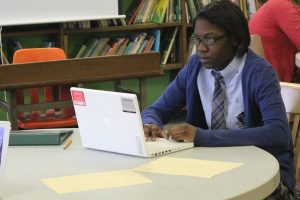
https://vimeo.com/37129487]
A lot has changed since John B. Stetson Middle School, a mostly Latino school in Hunting Park, changed from being run by the Philadelphia School District to its current charter organization, ASPIRA PA, said Principal Renato Lajara.
For instance, two years ago, Stetson was listed as “persistently dangerous,” or a school with dozens of violent incidents and hundreds of suspensions. That, coupled with low test scores and a dangerous school environment, forced the district to hand over operation of the school to ASPIRA, a Latino education group based in Hunting Park that runs several charter schools in the city. In September 2010, Stetson re-opened its doors with ASPIRA in charge. It was the same school, in the same building, with the same principal and the same students. But ASPIRA was determined to turn the school around.

Alfredo Calderon, the executive Director at ASPIRA PA, said the nonprofit that now manages Stetson changed the attitude of teachers. “At the end of the day, when they left for home they left tired. But they will have that kind of tired that is from accomplishing something, from teaching, from seeing kids learn. Not tired from being frustrated, not from stopping kids from getting in trouble or keeping order in the classroom.”
ASPIRA kept Renato Lajara on as principal. However, the staff had to re-apply to retain their jobs. About 70 percent of the teachers chose to leave.
New staff was just the beginning. ASPIRA spent generously to fix up the school — replacing shattered windows, broken door knobs and peeling paint. They cleaned the gym, replaced old desks and chairs, bought new books and upgraded the technology.
Class sizes used to average 33 students. Now, classes have between 20 and 22 students. Teachers have an average of five years experience here. They’re mostly young and bring enthusiasm and a fresh approach to teaching. And unlike Philadelphia’s public schools, teachers at Stetson are not in a union. Stetson teachers say they don’t mind, especially given the benefits at charters compared to public schools.
“In those schools, we didn’t have enough books, kids could come and go as they please, they didn’t have to wear uniform, there was nothing in place,” said Alison Sorrenson, who teaches 8th grade literacy and social studies. She’s taught in Philadelphia public schools for the last eight years in the neighborhood, but it’s her second year at Stetson.
“We have instant support. We have a ton of technology,” she said. Every morning, ASPIRA mandates students have group guidance sessions, where students share what they are struggling with, and how to deal with those problems. “I didn’t buy it at first, but it works,” Sorreson said.

When students share their experiences, they make for a more positive learning experience, said Catherine Lawrence, the school psychologist.
“I think that students are really able to process that everything happens from the morning or the previous day and get support from their teachers and peers and to get that extra support. If they’re able to get that social and emotional support, they’re able to work through that and learn math and reading and social science.”
Officials at ASPIRA PA call the nonprofit an “investment in Latino youth.” But some critics argue that’s not the right approach educators should take. Jerry Jordan, president of the Philadelphia Federation of Teachers — one of the city’s largest unions — said in a November article in Philadelphia Weekly that emphasizing a particular culture undoes the progression of schools over the past few decades.
“We go back to our separate and unequal system that we had in this country since Brown v. Board of [Education],” he said.
But Brett Wade, one of the school’s program directors, said that while roughly 90 percent of its students are Latino, ASPIRA PA offers more than just Latino-focused learning. Additionally, it avoids sending students home for suspensions and expulsions, unlike public schools.
ASPIRA also recommends students walk in “protocol.” For instance, when students change classes, they must remain quiet and walk in a single file with their hands behind their backs.

Discipline is something Precious Paulin has learned to appreciate.
“My mom sees a big change in me. I’m not disrespectful to anybody no more. And when I do, they keep me back on track,” Paulin said.
And it has showed in students. Last year, students increased in math performance by 22 points and in reading by eight. Wade expects that number to increase again this year.


Be the first to comment